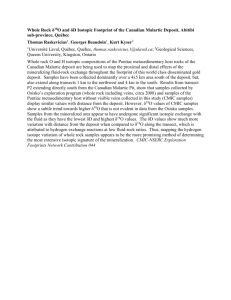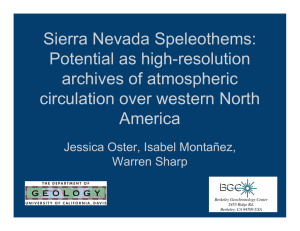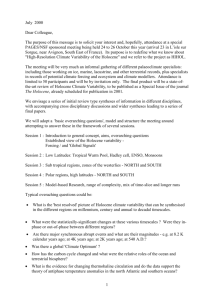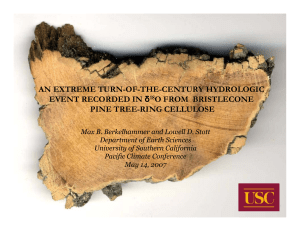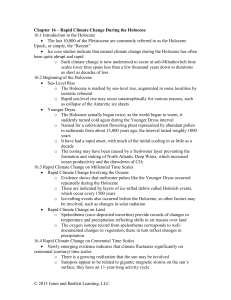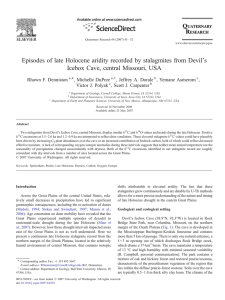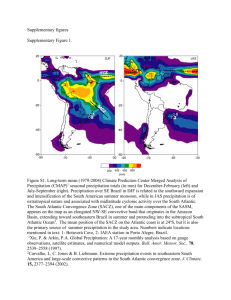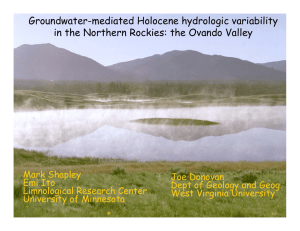so largely during the warmer months (Simpkins, δ
advertisement
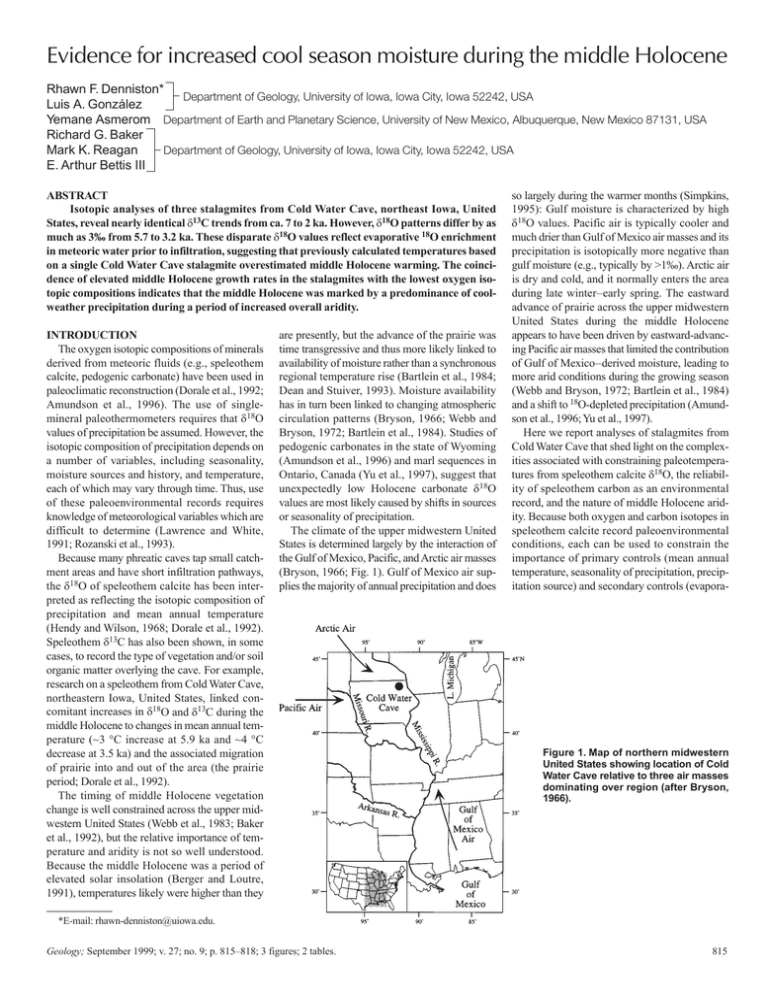
Evidence for increased cool season moisture during the middle Holocene Rhawn F. Denniston* Department of Geology, University of Iowa, Iowa City, Iowa 52242, USA Luis A. González Yemane Asmerom Department of Earth and Planetary Science, University of New Mexico, Albuquerque, New Mexico 87131, USA Richard G. Baker Mark K. Reagan Department of Geology, University of Iowa, Iowa City, Iowa 52242, USA E. Arthur Bettis III ABSTRACT Isotopic analyses of three stalagmites from Cold Water Cave, northeast Iowa, United States, reveal nearly identical δ13C trends from ca. 7 to 2 ka. However, δ18O patterns differ by as much as 3‰ from 5.7 to 3.2 ka. These disparate δ18O values reflect evaporative 18O enrichment in meteoric water prior to infiltration, suggesting that previously calculated temperatures based on a single Cold Water Cave stalagmite overestimated middle Holocene warming. The coincidence of elevated middle Holocene growth rates in the stalagmites with the lowest oxygen isotopic compositions indicates that the middle Holocene was marked by a predominance of coolweather precipitation during a period of increased overall aridity. INTRODUCTION The oxygen isotopic compositions of minerals derived from meteoric fluids (e.g., speleothem calcite, pedogenic carbonate) have been used in paleoclimatic reconstruction (Dorale et al., 1992; Amundson et al., 1996). The use of singlemineral paleothermometers requires that δ18O values of precipitation be assumed. However, the isotopic composition of precipitation depends on a number of variables, including seasonality, moisture sources and history, and temperature, each of which may vary through time. Thus, use of these paleoenvironmental records requires knowledge of meteorological variables which are difficult to determine (Lawrence and White, 1991; Rozanski et al., 1993). Because many phreatic caves tap small catchment areas and have short infiltration pathways, the δ18O of speleothem calcite has been interpreted as reflecting the isotopic composition of precipitation and mean annual temperature (Hendy and Wilson, 1968; Dorale et al., 1992). Speleothem δ13C has also been shown, in some cases, to record the type of vegetation and/or soil organic matter overlying the cave. For example, research on a speleothem from Cold Water Cave, northeastern Iowa, United States, linked concomitant increases in δ18O and δ13C during the middle Holocene to changes in mean annual temperature (~3 °C increase at 5.9 ka and ~4 °C decrease at 3.5 ka) and the associated migration of prairie into and out of the area (the prairie period; Dorale et al., 1992). The timing of middle Holocene vegetation change is well constrained across the upper midwestern United States (Webb et al., 1983; Baker et al., 1992), but the relative importance of temperature and aridity is not so well understood. Because the middle Holocene was a period of elevated solar insolation (Berger and Loutre, 1991), temperatures likely were higher than they are presently, but the advance of the prairie was time transgressive and thus more likely linked to availability of moisture rather than a synchronous regional temperature rise (Bartlein et al., 1984; Dean and Stuiver, 1993). Moisture availability has in turn been linked to changing atmospheric circulation patterns (Bryson, 1966; Webb and Bryson, 1972; Bartlein et al., 1984). Studies of pedogenic carbonates in the state of Wyoming (Amundson et al., 1996) and marl sequences in Ontario, Canada (Yu et al., 1997), suggest that unexpectedly low Holocene carbonate δ18O values are most likely caused by shifts in sources or seasonality of precipitation. The climate of the upper midwestern United States is determined largely by the interaction of the Gulf of Mexico, Pacific, and Arctic air masses (Bryson, 1966; Fig. 1). Gulf of Mexico air supplies the majority of annual precipitation and does so largely during the warmer months (Simpkins, 1995): Gulf moisture is characterized by high δ18O values. Pacific air is typically cooler and much drier than Gulf of Mexico air masses and its precipitation is isotopically more negative than gulf moisture (e.g., typically by >1‰). Arctic air is dry and cold, and it normally enters the area during late winter–early spring. The eastward advance of prairie across the upper midwestern United States during the middle Holocene appears to have been driven by eastward-advancing Pacific air masses that limited the contribution of Gulf of Mexico–derived moisture, leading to more arid conditions during the growing season (Webb and Bryson, 1972; Bartlein et al., 1984) and a shift to 18O-depleted precipitation (Amundson et al., 1996; Yu et al., 1997). Here we report analyses of stalagmites from Cold Water Cave that shed light on the complexities associated with constraining paleotemperatures from speleothem calcite δ18O, the reliability of speleothem carbon as an environmental record, and the nature of middle Holocene aridity. Because both oxygen and carbon isotopes in speleothem calcite record paleoenvironmental conditions, each can be used to constrain the importance of primary controls (mean annual temperature, seasonality of precipitation, precipitation source) and secondary controls (evapora- Figure 1. Map of northern midwestern United States showing location of Cold Water Cave relative to three air masses dominating over region (after Bryson, 1966). *E-mail: rhawn-denniston@uiowa.edu. Geology; September 1999; v. 27; no. 9; p. 815–818; 3 figures; 2 tables. 815 tive enrichment of fluid 18O) on the speleothem paleoclimatic record. GEOLOGIC SETTING Cold Water Cave is an ~8-km-long, tunnelshaped cave that developed in the Dunleith Formation of the Galena Group Dolomite (Middle and Upper Ordovician) in Winnishiek County, northeast Iowa (43°28′N, 91°58′W; Levorson and Gerk, 1972; Fig. 1). The vertical distance between the land surface and the cave is ~30 m. Cold Water Creek flows through Cold Water Cave and discharges from the cave through a series of sumps, blocking the only natural entrance and isolating the cave from the outside atmosphere. Partial pressures of CO2 in the cave remain constant throughout the year (Suzuki, 1998), and the creek maintains nearly 100% humidity in the cave, thus making Cold Water Cave an ideal environment for equilibrium speleothem growth. The fluvial record in northeast Iowa suggests that ground-water levels remained sufficiently high throughout the middle Holocene to keep the entrance submerged (Baker et al., 1996). RESEARCH METHODS We have conducted additional analyses on 1S, the stalagmite utilized by Dorale et al. (1992), and detailed petrographic and isotopic study of two additional stalagmites, 2SS and 3L. Each stalagmite is composed of optically clear calcite with extremely fine fluorescent banding on the scale of tens of microns. Stable isotopic samples were extracted using a drill with a 0.5 mm bit. Each sample incorporated ~10–100 fluorescent bands. Larger samples, composed of 100–500 fluorescent bands, were dated by U-Th thermal ionization mass spectrometry (TIMS). U-Th analysis of stalagmite 2SS was performed at the University of New Mexico Radiogenic Isotope Laboratory. The chemical separation was modified from Chen et al. (1986). U and Th were measured on a Micromass Sector 54 thermal ionization mass spectrometer with a high-abundance sensitivity filter. All isotopes of interest were measured on an ion-counting Daly multiplier with abundance sensitivity in the range of 20 ppb at one mass distance in the mass range of U and Th, requiring very little background correction even for samples with large 232 Th content. Multiplier dark noise was about 0.12 counts per second. The NBL-112 U standard was measured during the course of this study and was always in the range of 1‰ of the accepted 234U/ 238U ratio. Stalagmites 1S and 3L were dated at Los Alamos National Laboratory using methods outlined in Dorale et al. (1992) (Table 1). Carbon and oxygen isotopic analyses were performed at the University of Michigan Stable Isotope Laboratory using a MAT251 gas-source mass spectrometer. Samples were converted to CO2 with phosphoric acid at 72°C. All values are reported in per mil (‰) with oxygen relative to standard mean ocean water (SMOW) and carbon relative to Peedee belemnite (PDB); analytical precision is better than 0.05‰. PREVIOUS RESEARCH ON STALAGMITE 1S Dorale et al. (1992) defined three climatic stages based on the temporal variability of both δ18O and δ13C in stalagmite 1S. Stage 1 refers to an inferred cool and/or moist period from 7.77 to 5.90 ka that is characterized by speleothem δ13C and δ18O values averaging –8.5‰ and 24.7‰, respectively. Stage 2 is characterized by δ13C values that increase steadily from –9‰ at 5.90 ka to –5‰ at 3.60 ka and a concomitant increase in δ18O values to ~25.8‰. These shifts were interpreted to reflect rising middle Holocene temperatures and the replacement of deciduous forests by prairie. During stage 3, δ13C values decreased gradually to –8‰ by ca. 2.0 ka, and while δ18O values dropped abruptly to an average of 24.1‰. These changes in δ18O values are interpreted to have resulted from increased moisture and cooler temperatures returning to the upper midwestern United States, and the change in δ13C values reflects the subsequent replacement of prairie by oak dominated forests and savannas. RESULTS Growth rates, calculated by interpolation between radiometric dates, vary between and within stalagmites (Table 2). Stalagmite 3L grew at the fastest overall rate, with maximum growth rates during the middle Holocene (5.9–3.5 ka). 1S grew at the second fastest rate, with the most rapid growth prior to 5.9 ka and the slowest growth rate during the late Holocene. Stalagmite 2SS had the slowest cumulative growth and, like 3L, grew at its fastest rate during the middle Holocene. These slow speleothem growth rates preclude testing for equilibrium calcite crystalli- 816 GEOLOGY, September 1999 zation by measuring δ13C and δ18O covariance along time-equivalent growth horizons. Carbon isotopic trends in the two recently analyzed stalagmites, 2SS and 3L, are similar to the trend observed in 1S (Fig. 2). Beginning at 5.9 ka, the δ13C in each stalagmite increased by 2‰, then decreased at 3.2 ka, and finally stabilized 1‰ lower by 2.0 ka. Stalagmites 1S and 3L are nearly identical, with values within 0.05‰ between 5.9 and 2.2 ka. In addition, many details are shared among trends of 1S and 3L, particularly between 7.8 and 4.0 ka (Fig. 2). Oxygen isotopic trends prior to and after the prairie period (5900 to 3500 years BP) are similar (stage 2 of Dorale et al., 1992). However, during the prairie period, the δ18O values of 1S were substantially higher than 2SS and 3L (Fig. 2) and values for 2SS were lower than those in 3L or 1S. Quadrupling the sampling resolution of stalagmite 1S preserved the 18O enrichment during the prairie period reported by Dorale et al. (1992); however, it revealed (1) that δ18O values shifted abruptly ~200 yr after the onset of the increase in δ13C values (ca. 5.7 ka); and (2) the presence of four pronounced negative spikes, ranging from 1‰ to 2‰ in magnitude, between 4.8 and 3.5 ka. The δ18O values in 3L exhibits significant short-term variability, but time-averaged values remain largely unchanged between 8.5 and 2.0 ka. The δ18O of 3L averaged 24.5‰ ± 0.2‰ prior to 5.9 ka, 24.5‰ ± 0.3‰ from 5.9 to 2.2 ka, and 24.6‰ ± 0.2‰ after 2.2 ka. In stalagmite 2SS, δ18O values decreased gradually from 24.6‰ at 7.6 ka to 24.0‰ at 4.8 ka. Oxygen isotopic compositions then increased and stabilized at ~24.1‰ by 3.2 ka. DISCUSSION Under the cool and extremely humid conditions that prevail in Cold Water Cave, evaporation is minimal, and CO2 outgassing is predominantly responsible for speleothem growth (Suzuki, 1998). Thus, the carbon isotopic composition of each stalagmite records the same vegetation-induced changes in soil organic matter that occurred over the cave. This is supported by the fact that the timing of the onset of the large increase in δ13C values at 5.9 ka (which defines the start of the prairie period at Cold Water Cave) is nearly identical in all three stalagmites. In addition, each stalagmite exhibits carbon isotopic shifts of equal magnitude, and δ13C values are very similar among stalagmites during the prairie-dominated middle Holocene. Because the oxygen in speleothem calcite is derived exclusively from meteoric water, the distinct middle Holocene oxygen isotopic trends of these three stalagmites must have their origin in changes in the composition of the solutions prior to infiltration (i.e., prior to carbon being added to the solution). The differential enrichment of 18O prior to infiltration can be easily explained by differences in slope aspect over the cave. Stalagmite 1S, the one most enriched in 18O, formed in a passage that underlies primarily south-facing slopes, whereas 2SS, the one least enriched in 18O, is overlain by north-facing hill sides (Fig. 3). The catchment area for 3L, the δ18O values of which are between 1S and 2SS, is relatively flat lying. South-facing slopes have greater exposure to sunlight and are susceptible to greater evaporative effects than north-facing slopes. The effect of evaporation on infiltrating fluids would have been more pronounced during the prairie period because of the absence of a protective tree canopy. That δ18O values in 1S increased so abruptly and that this shift postdates the arrival of prairie also indicate that evaporative enrichment of 18O was modulated by vegetation change. Other studies have suggested that soil water in arid environments, as recorded by pedogenic carbonates, can be enriched in 18O by as much as 6‰ relative to mean annual precipitation (Amundson et al., 1996; Quade et al., 1989). In addition, data from Mammoth Cave, Kentucky, show an ~2‰ increase in δ18O values of speleothem calcite in stalagmites forming under south-facing slopes relative to those forming under north-facing slopes (González, 1989). It is not safe, however, to assume that because elevated δ18O values associated with the middle Holocene record of 1S are related to evaporative enrichment of 18O, then the stalagmite with the lowest δ18O value (2SS) should most accurately record mean annual temperature. Temperature, moisture source, and seasonality each affect the isotopic composition of precipitation (Dansgaard, 1964; Gat, 1980; Simpkins, 1995). If temperature alone controlled the lower δ18O values of 2SS, mean annual temperatures would have begun decreasing at 4.9 ka with maximum cooling of ~2 °C at 4.2 ka. However, no other evidence supports middle Holocene cooling here. Figure 2.Temporal trends of carbon and oxygen isotopic compositions in stalagmites 1S, 2SS, and 3L. Horizontal bars represent dated areas and vertical bars are 2σ uncertainties. SMOW— standard mean ocean water. Figure 3. Map of Cold Water Cave relative to topography of overlying ground surface. Approximate catchment areas for stalagmites 1S (south-facing slope), 2SS (north-facing slope), and 3L (flat-lying hill top) are located within open circles. SE is shaft entrance to cave. Contour interval is ~6 m. Dashed lines are streams. GEOLOGY, September 1999 817 An alternative scenario is that moisture was derived from a more 18O-depleted source during the middle Holocene than it is today. In Iowa, δ18O values of moisture derived from the Gulf of Mexico are ≥ 3‰ higher than a mixed Gulf of Mexico–Pacific source (Simpkins, 1995). If a similar relationship existed during the middle Holocene, then increases in relative amounts of precipitation derived from Pacific moisture sources would also have resulted in lower precipitation δ18O values without any major change in mean annual temperature. Because Pacific air is drier than Gulf of Mexico air, a predominance of Pacific air would have resulted in increased aridity. Although dry conditions are necessary to drive the forest-prairie transition and have been documented for the middle Holocene (Baker et al., 1992; Dean and Stuiver, 1993; Smith et al., 1997), consistent increases in growth rates in 2SS and 3L necessitate greater infiltration. The low δ18O values and high growth rates during the middle Holocene in stalagmites 2SS and 3L can be best explained by a shift toward increased cool season precipitation during the middle Holocene. Yu et al. (1997) proposed that fall-winter Gulf of Mexico or Pacific storms reached the upper midwestern United States with increased frequency during the middle Holocene. Cool-weather precipitation is 18O-depleted compared to warm weather precipitation, and moisture delivered outside of the growing season would result in less being intercepted by vegetation, leading to increased infiltration of low δ18O fluids (and thus to increased speleothem growth rates). The advance of prairie would not have been significantly influenced by increased coolseason moisture if it was accompanied by increased aridity during the growing season. Lower lake levels during the middle Holocene (Smith et al., 1997; Yu et al., 1997) can be reconciled with increased cool-season precipitation if summer evaporation rates were sufficiently high to offset rises in winter lake levels. The four negative δ18O spikes in 1S are puzzling. The fact that the oxygen isotopic values for these spikes is similar to average oxygen isotopic values from the same time interval in 2SS suggests that these spikes represent periods during which 1S crystallized from fluids that had not been significantly fractionated by evaporation on the land surface. Thus, the spikes may record speleothem growth during particularly wet years or decades. CONCLUSIONS The effects of moisture source, mean annual temperature, the seasonality of precipitation, and evaporation affect the oxygen isotopic composition of speleothem calcite and complicate paleoenvironmental interpretations. The similarity of carbon trends throughout each of the stalagmites analyzed in this study demonstrates that differences in oxygen isotopic compositions during the 818 prairie period at Cold Water Cave are artifacts of pre-infiltration evaporative effects. Therefore, previously calculated speleothem-based temperature estimates for the middle Holocene are too high, although no new estimates can be made from these data. Increased speleothem growth rates during the prairie period suggest that cool season precipitation/infiltration increased during the middle Holocene, while higher growing season aridity offset additional winter moisture. ACKNOWLEDGMENTS We thank K. and W. Flatland, C. Shorey, A. Suzuki, and J. Dorale. Supported by National Ocean and Atmospheric Administration grant NA366PO238 and by the Center for Global and Regional Environmental Research (to González, Reagan, and Baker). U/Th isotopic data on stalagmites 1S and 3L were provided by D. Pickett. REFERENCES CITED Amundson, R., Chadwick, O., Kendall, C., Wang, Y., and DeNiro, M., 1996, Isotopic evidence for shifts in atmospheric circulation patterns during the late Quaternary in mid-North America: Geology, v. 24, p. 23–26. Baker, R. G., Bettis, E. A., III, Schwert, D. P., Horton, D. G., Chumbley, C. A., González, L. A., and Reagan, M. K., 1996, Holocene paleoenvironments of northeast Iowa: Ecological Monographs, v. 66, p. 203–234. Baker, R. G., Maher, L. J., Chumbley, C. A., and Van Zant, K. L., 1992, Patterns of Holocene environmental change in the midwestern United States: Quaternary Research, v. 37, p. 379–389. Bartlein, P. J., Webb, T., III, and Fleri, E., 1984, Holocene climatic change in the northern Midwest; pollen-derived estimates: Quaternary Research, v. 22, p. 361–374. Berger, A., and Loutre, M. F., 1991, Insolation values for the climate of the last 10 million years: Quaternary Science Reviews, v. 10, p. 297–317. Bryson, R. A., 1966, Air masses, streamlines, and the boreal forest: Geographical Bulletin, v. 8, p. 228–269. Chen, J., Edwards, L., and Wasserburg, W., 1986, 238U, 234U, and 232Th in seawater: Earth and Planetary Science Letters, v. 80, p. 241–251. Dansgaard, W., 1964, Stable isotopes in precipitation: Tellus, v. 16, p. 436–468. Dean, W. E., and Stuiver, M., 1993, Stable carbon and oxygen isotope studies of the sediments of Elk Lake, Minnesota, in Bradbury, J. P., and Dean, W. E., eds., Elk Lake, Minnesota: Evidence for rapid climate change in the north-central United States: Geological Society of America Special Paper 276, p. 163–180. Dorale, J. A., González, L. A., Reagan, M. K., Pickett, D. A., Murrell, M. T., and Baker, R. G., 1992, A high-resolution record of Holocene climate change in speleothem calcite from Cold Water Cave, northeast Iowa: Science, v. 258, p. 1626–1630. Gat, J. R., 1980, The isotopes of hydrogen and oxygen in precipitation, in Fritz, P., and Fontes, J., eds., Handbook of environmental isotope geochemistry: New York, Elsevier, p. 21–44. Printed in U.S.A. González, L. A., 1989, Inorganic calcium carbonate precipitation: Controls on mineralogy, morphology, and trace elemental composition [Ph.D. thesis]: Ann Arbor, University of Michigan, 188 p. Hendy, C. H., and Wilson, A. T., 1968, Palaeoclimatic data from speleothems: Nature, v. 216, p. 48–51. Lawrence, J. R., and White, J. W. C., 1991, The elusive climate signal in the isotopic composition of precipitation, in Taylor, H. P., et al., eds., Stable isotope geochemistry: A tribute to Samuel Epstein: Geochemical Society Special Publication 3, p. 169–185. Levorson, C. O., and Gerk, A. J., 1972, A preliminary stratigraphic study of the Galena Group of Winneshiek County, Iowa: Iowa Academy of Science Proceedings, v. 79, p. 111–122. Quade, J., Cerling, T., and Bowman, J., 1989, Systematic variations in the carbon and oxygen isotopic composition of pedogenic carbonate along elevation transects in the southern Great Basin, United States: Geological Society of America Bulletin, v. 101, p. 464–475. Rozanski, K., Araguás-Araguás, L., and Gonfiantini, R., 1993, Isotopic patterns in modern global precipitation, in Swart, P. K., et al., eds., Climate change in continental isotopic records: American Geophysical Union Geophysical Monograph 78, p. 1–36. Simpkins, W. W., 1995, Isotopic composition of precipitation in central Iowa: Journal of Hydrology, v. 172, p. 185–207. Smith, A. J., Donovan, J. J., Ito, E., and Engstrom, D. R., 1997, Ground-water processes controlling a prairie lake’s response to middle Holocene drought: Geology, v. 25, p. 391–394. Suzuki, A., 1998, The geochemical evolution of vadose fluids and gases above Cold Water Cave, northeast Iowa: Transportation and preservation of seasonal climatic signals; [M.S. thesis]: Iowa City, University of Iowa, 64 p. Webb, T., III, and Bryson, R. A., 1972, Late- and postglacial climatic change in the northern Midwest, USA: Quantitative estimates derived from fossil pollen spectra by multivariate statistical analysis: Quaternary Research, v. 2, p. 70–115. Webb, T., III, Cushing, E. J., and Wright, H. E., Jr., 1983, Holocene changes in the vegetation of the Midwest, in Wright, H. E., ed., Late Quaternary environments of the United States: Minneapolis, Minnesota, University of Minnesota Press, p. 142–165. Yu, Z., McAndrews, J. H., and Eicher, U., 1997, Middle Holocene dry climate caused by changes in atmospheric circulation patterns: Evidence from lake levels and stable isotopes: Geology, v. 25, p. 251–254. Manuscript received December 14, 1998 Revised manuscript received May 19, 1999 Manuscript accepted June 4, 1999 GEOLOGY, September 1999
